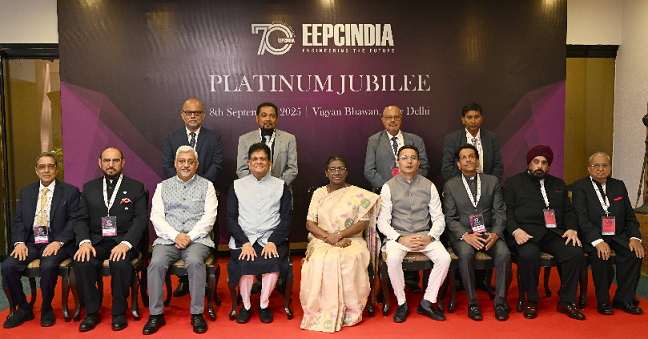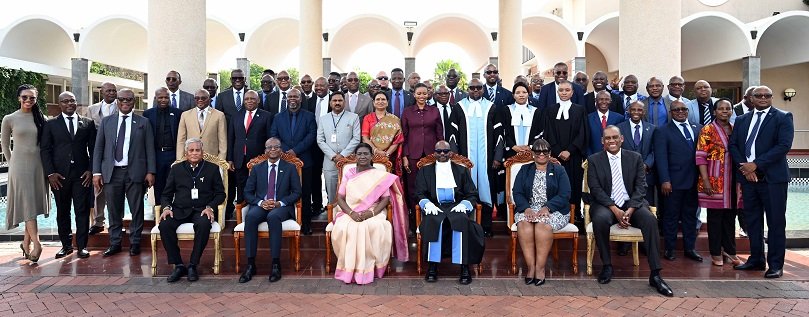Last Updated on November 17, 2025 7:38 pm by BIZNAMA NEWS
R. Suryamurthy
India’s trade numbers for October landed with a thud on Monday, as a steep jump in imports — led largely by an extraordinary spike in gold inflows — collided with a broad-based slump in merchandise exports. The result was a record monthly trade deficit of US$41.7 billion, underscoring the growing pressures on India’s external account at a time of soft global demand, domestic festive-season distortions and evolving tariff risks abroad.
The Commerce Ministry’s provisional data shows total exports (merchandise + services) for October at US$72.89 billion, marginally lower than a year earlier. Imports, however, surged 14.9% to US$94.70 billion, driving the overall deficit to US$21.80 billion, more than double last year’s level.
Merchandise slump meets a gold-import shock
Merchandise exports fell 11.8% year-on-year to US$34.38 billion, the weakest in eleven months. Almost every heavyweight category — engineering goods, petroleum products, gems and jewellery, textiles, pharmaceuticals, plastics, and chemicals — posted contraction.
Imports, by contrast, touched an all-time high of US$76.06 billion, fuelled by a tripling of gold imports to US$14.7 billion, according to ICRA’s Chief Economist Aditi Nayar. “Speculative purchases ahead of the festive season, in a backdrop of uninterrupted rise in gold prices, likely drove the surge,” she said, adding that the spike “may not sustain”, offering some hope of moderation in November–December.
Even excluding oil and gold, underlying demand remained firm: non-oil, non-gold imports rose 12.4%, reflecting robust inflows of fertilisers, machinery, electronics, non-ferrous metals and silver.
This combination pushed the merchandise trade deficit to US$41.68 billion in October alone — far above the US$26.2 billion gap recorded a year earlier. ICRA now expects the current account deficit to widen sharply to 2.4–2.5% of GDP in Q3 FY26, from roughly 1.8% the previous quarter.
Exporters face global slowdown — and new tariff headwinds
Exporters’ associations struck a sombre tone. FIEO President S.C. Ralhan said October’s numbers show a “mixed but worrying trend”, with resilient services activity offset by “a sharper fall in dominant merchandise sectors.”
The FIEO chief said weaker engineering, petroleum, gems and jewellery, textiles and chemicals shipments reflected a combination of global softness, geopolitical uncertainty, and cost pressures at home. He added that rising imports of components and raw materials highlight India’s persistent dependence on overseas supply chains.
Engineering goods — India’s single-largest export category — were particularly hard hit. Shipments tumbled 16.7% to US$9.37 billion, a fall EEPC India Chairman Pankaj Chadha attributed largely to the 50% punitive tariff imposed by the Trump administration, which took effect in late August. “The decline was expected,” Chadha said, though he noted that government support measures had helped cushion the early blow.
Despite the October shock, cumulative engineering exports for April–October remain in positive territory due to stronger performance earlier in the year.
Services provide some relief
Amid the gloom, services exports offered a modest counterweight. The ministry estimates October services exports at US$38.52 billion, up from US$34.41 billion last year. Services imports also rose, but the sector continues to deliver a sizeable surplus — US$118.68 billion during April–October — helping blunt the merchandise gap.
April–October snapshot: growth, but with widening imbalances
For the first seven months of FY26, India’s total exports stand at US$491.80 billion, up 4.84% from the same period in FY25. Merchandise exports grew only marginally (0.63%), but services exports jumped 9.75%.
Imports, however, grew faster. Total inflows for April–October reached US$569.95 billion, a 5.74% rise. The merchandise trade deficit widened to US$196.82 billion, compared to US$171.40 billion a year earlier.
Non-petroleum exports showed some resilience, rising 3.92% to US$219.90 billion, while non-petroleum imports surged 10.2%. Growth pockets in October included cashew (126.85%), meat, dairy & poultry (30.87%), electronics (19.05%), marine products (11.08%), and coffee (10.91%) — all modest but welcome offsets to broader declines.
Exporters seek more relief as policy pressures mount
With the twin challenges of weaker global demand and rising protectionism — particularly from the U.S. — exporters are pressing for deeper domestic support.
Ralhan urged faster release of export benefits, easier and cheaper credit access, and further reductions in compliance costs. He welcomed the government’s Export Promotion Mission and additional credit guarantees, while calling on the RBI to extend relief measures more broadly across sectors affected by reciprocal tariffs.
Chadha of EEPC also pointed to India’s ongoing free-trade agreement negotiations and recently concluded deals with the UAE, UK, and Australia, arguing these will be crucial for hitting the engineering sector’s US$250 billion export target by 2030.
The road ahead
Economists expect the October numbers to be an outlier — unusually distorted by gold inflows and the early festive calendar. But the underlying signals are harder to ignore: softening global demand, tariff risks in key markets, and persistent reliance on imported industrial inputs continue to weigh on India’s trade outlook.
Any cooling in gold imports over the next two months may narrow the deficit slightly. What remains uncertain is whether merchandise exports — squeezed by both cyclical and structural pressures — can regain enough momentum to stabilise the external account heading into 2026.



